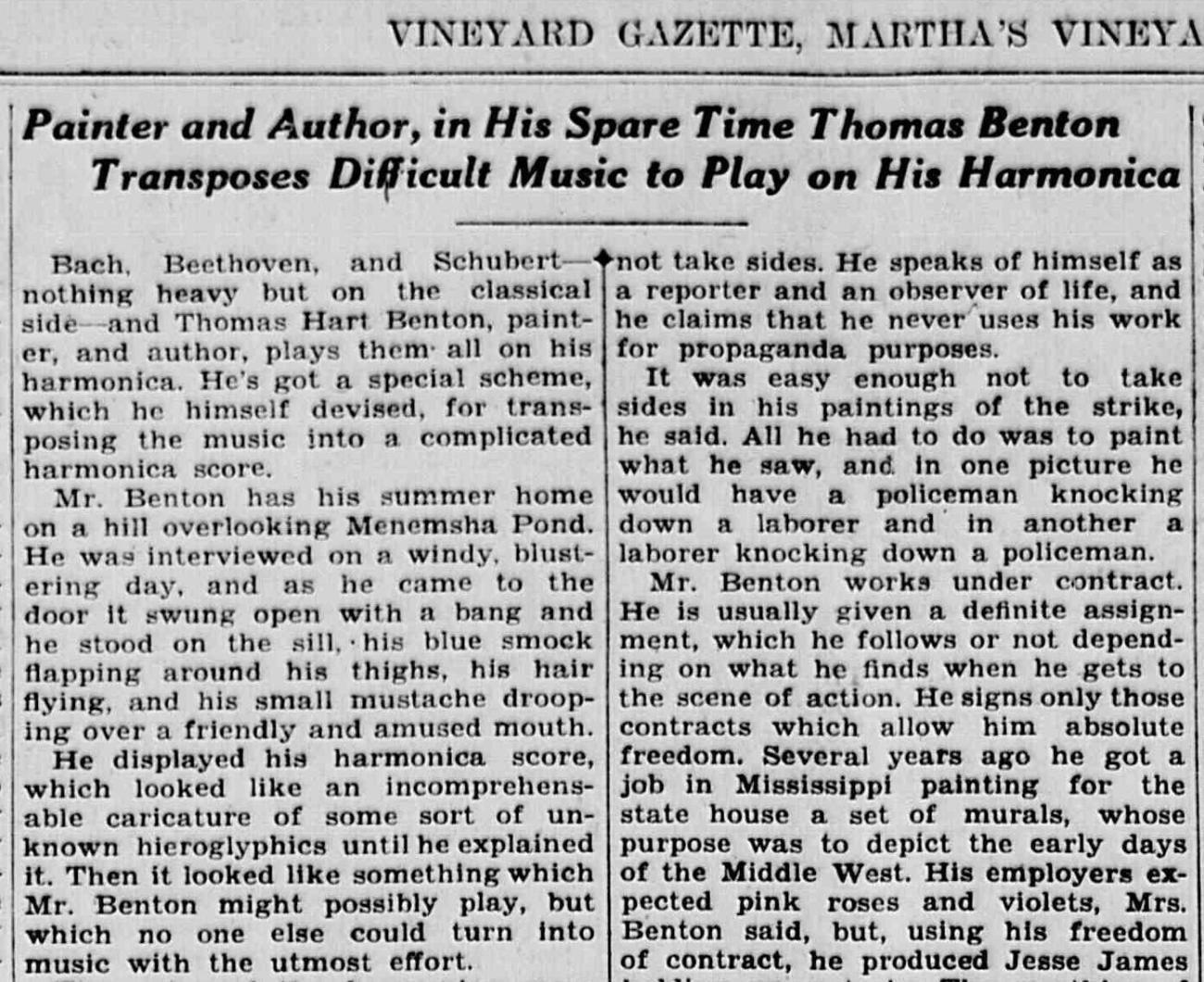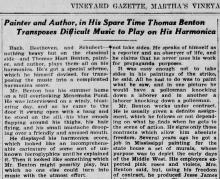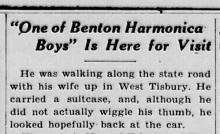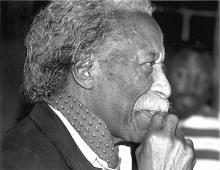Bach, Beethoven, and Schubert - nothing heavy but on the classical side - and Thomas Hart Benton, painter, and author, plays them all on his harmonica. He’s got a special scheme, which he himself devised, for transposing the music into a complicated harmonica score.
Mr. Benton has his summer home on a hill overlooking Menemsha Pond. He was interviewed on a windy, blustering day, and as he came to the door it swung open with a bang and he stood on the still, his blue smock flapping around his thighs, his hair flying, and his small mustache drooping over a friendly and amused mouth.
He displayed his harmonica score, which looked like an incomprehensible caricature of some sort of unknown hieroglyphics until he explained it. Then it looked like something which Mr. Benton might possibly play, but which no one else could turn into music with the utmost effort.
The notes of the harmonica score are designated not on a cleft but by number. An arrow pointing up at the number tells Mr. Benton to blow out, while an arrow pointing down tells him to suck in. This method of scoring is particularly good, he explained, because it can be used in any key. The key note of every harmonica is always the same number. Hence he never has to transpose.
Denies He’d Rather Play than Paint
It turned out that Mr. Benton was not the only one who could follow his score. His wife and his small boy can both play it too. But Mr. Benton enjoys playing the most. “I think he’d rather play the harmonica than paint,” Mrs. Benton volunteered. But her husband vigorously denied that she was right.
Mr. Benton has just returned to the Vineyard after having been sent to Michigan by Life to paint pictures of the strikes. “I went to see if I could find a revolution there,: he said, “But I found that I couldn’t.”
He found work to do, however, because, as he said, he can always find something to paint. He did some twenty-five paintings which he says will probably appear in next week’s issue of Life. His job in Michigan he described as one almost like that of a reporter.
In his work on labor trouble, as in all his other work, Mr. Benton does not take sides. He speaks of himself as a reporter and an observer of life, and he claims that he never uses his work for propaganda purposes.
It was easy enough not to take sides in his paintings of the strike, he said. All he had to do was to paint what he saw, and in one picture he would have a policeman knocking down a laborer and in another a laborer knocking down a policeman.
Mr. Benton works under contract. He is usually given a definite assignment, which he follows or not depending on what he finds when he gets to the scene of action. He signs only those contracts which allow him absolute freedom. Several years ago he got a job in Mississippi painting for the state house a set of murals, whose purpose was to depict the early days of the Middle West. His employers expected pink roses and violets, Mrs. Benton said, but, using his freedom of contract, he produced Jesse James holding up a train. The worthies of the Middle West were not pleased.
Mr. Benton is a prolific artist. During the past year he has painted 45,000 square feet of murals, sixty odd drawings, six lithographs, has written a 100,000 word book, 50,000 words of articles, and has delivered fifteen lectures.
Turned Into a Travel Book
His 100,000 word book, entitled An Artist in America, which will be published this fall, started out to be an autobiography, but according to Mr. Benton, has turned into something of a travel book. “Why, I only enter the first two chapters. I was looking over the thing the other night and I noticed.”
Before his job in Michigan, Mr. Benton was collecting material in the flood districts of Missouri. At present he is working on this material. He no longer paints Vineyard scenes. “There is such a thing as becoming satiated with a place,” he explained. “I know the Vineyard too well and too intimately to be able to paint it any more.”
Mr. Benton has been coming to the Vineyard of the past eighteen years. His first eight years he worked steadily on Vineyard scenes and Vineyard characters. “Portraits of Vineyarders are hanging in museums and collections all over the United States,” he said.










Comments